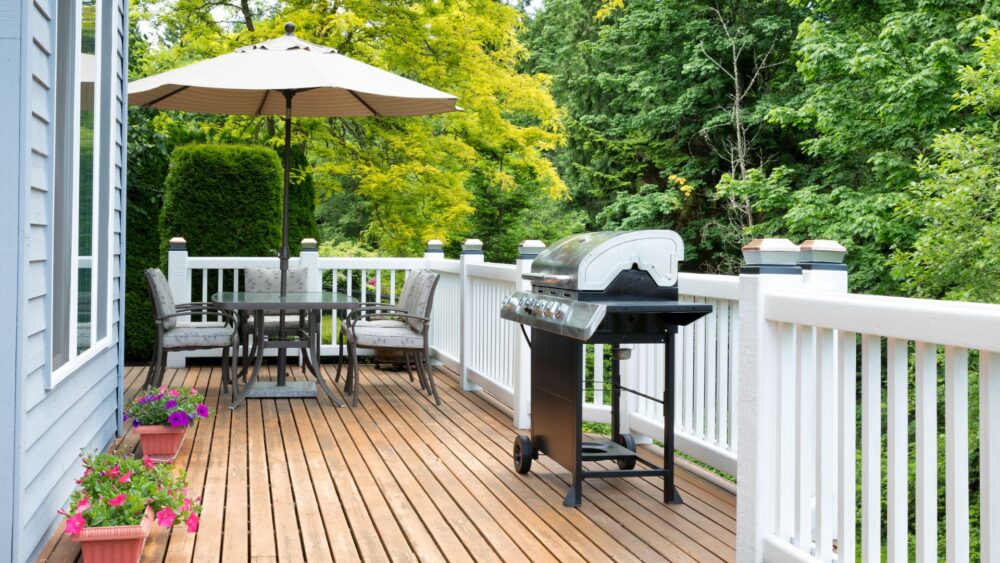Deck maintenance doesn’t have to be a chore that looms over every homeowner’s head like dark clouds before a storm. In fact, with the right approach, keeping your deck in prime condition can be surprisingly straightforward. So, whether you’re tackling the challenges of weather-beaten wood or simply addressing the usual wear and tear, these tips are here to make sure your outdoor area stays a cozy haven for relaxation instead of becoming a source of stress.
The secret? It’s all about routine care and knowing what signs of trouble to look out for—before they become major issues. So let’s step into the world of effective deck upkeep where small efforts lead to big rewards.
Deck Maintenance Do’s and Don’ts
Think of your deck as a natural extension of your living space. But it’s exposed to the elements 24/7.
So, to keep it shining and in tip-top shape, a little love and care go a long way. Here are the do’s and don’ts of deck maintenance.
Do Clean the Deck Thoroughly Once a Year
At least once a year, give your deck a deep clean. A thorough cleaning removes built-up dirt, debris, and stains.
The best time to clean your deck is in early spring. This preps it for heavy use in the summer months.
Don’t Go Overboard with the High-Powered Washer
A pressure washer makes quick work of cleaning a deck. But too much pressure can damage the wood.
Use the lowest setting that gets the job done. And keep the nozzle moving to avoid etching the wood.
Do Cover Nearby Shrubbery Before You Begin
Be cautious, because those deck cleaners and sealers you’re using might not be so friendly to your plants. Before you start, cover nearby shrubs and landscaping with a tarp.
This protects your greenery from overspray. Just be sure to remove the tarp as soon as you’re done.
Don’t Clean the Deck with Chlorine Bleach
Avoid using chlorine bleach to clean your deck. It can strip the wood of its natural color and damage the cellular structure.
Opt for an oxygen bleach cleaner instead. It’s gentler on wood but still effective at removing mold and mildew.
Do Sand Your Deck Before Sealing
Sanding your deck before sealing helps the sealer penetrate deeper into the wood. Use an 80-grit sandpaper to lightly sand the surface.
Focus on any areas that are splintered or rough. Sanding provides a smoother surface for the sealer to adhere to.
Don’t Use Paint as a Sealant
Paint may look nice at first, but it doesn’t protect wood as well as a sealer. Paint can chip and peel, leaving your deck vulnerable to the elements.
For the best protection, use a clear or tinted wood sealer. These penetrate the wood to repel water and prevent fading.
How to Properly Clean and Maintain Your Wood Deck
A wood deck is a beautiful addition to any home. But it requires regular upkeep to stay looking its best.
Here’s how to properly clean and maintain your wood deck:
Gather the Right Tools and Materials
Before you start, make sure you have the right supplies. You’ll need:
- Broom
- Garden hose or pressure washer
- Deck cleaner
- Stiff-bristled brush
- Rubber gloves
- Safety glasses
Sweep the Deck and Remove Debris
Start by removing all furniture and decor from the deck. Then, give it a good sweep to remove loose dirt and debris.
Pay extra attention to corners and crevices where leaves and twigs can collect. Use a putty knife to dislodge any stubborn debris between deck boards.
Use a Pressure Washer or Garden Hose
Next, thoroughly rinse the deck using a garden hose or pressure washer. If using a pressure washer, be careful not to get too close to the wood.
Hold the nozzle about 8 inches from the surface and use a fan-tip attachment. This will help avoid damaging the wood fibers.
Apply a Deck Cleaner or Brightener
Once the deck is wet, it’s time to apply the cleaner. Choose a cleaner that’s appropriate for your type of wood.
Follow the manufacturer’s instructions for mixing and application. Most cleaners can be applied using a garden sprayer, roller, or brush.
Scrub Stubborn Stains and Mildew
For heavily soiled areas or stubborn stains, some extra elbow grease may be required. Use a stiff-bristled brush to work the cleaner into the wood grain.
Give special attention to high-traffic areas and spots prone to mildew growth. When you scrub, you’re essentially giving your floors a deep clean by lifting stubborn dirt and grime that’s settled in over time.
Tips for Maintaining a Composite Deck
Composite decking is a popular choice for its low-maintenance appeal. But even composite decks require some regular upkeep.
Here are tips to keep your composite deck looking great:
Sweep Regularly to Remove Debris
Leaves, twigs, and other debris can scratch the surface of composite decking. Make a habit of sweeping your deck at least once a week.
Doing this simple step can really help keep that finish looking fresh and new for a long time. Use a soft-bristled broom or leaf blower on the lowest setting.
Clean with a Mild Soap and Water Solution
When your composite deck needs a more thorough cleaning, keep it simple. Mix a few squirts of dish soap with warm water in a bucket.
Use a soft-bristled brush to apply the soapy solution, then rinse with a garden hose. Avoid harsh chemicals or abrasive cleaners that can dull the finish.
Remove Stains Promptly
Spills happen, but it’s important to clean them up right away – especially on composite decking. Certain substances like red wine, grease, and sunscreen can cause permanent staining if left to set.
To remove a fresh stain, apply a composite deck cleaner to a cotton rag and blot the area. For stubborn spots, let the cleaner sit for a few minutes before wiping clean.
Identifying and Repairing Deck Damage
Even with proper maintenance, decks can suffer wear and tear over time. Regularly inspecting your deck can help catch small issues before they become big problems.
Here’s what to look for and how to make repairs:
Inspect for Rot, Warping, and Splintering
At least once a year, give your deck a thorough inspection. Check for signs of rot, such as soft or crumbling wood.
Look for boards that are warped, cupped, or splintered. These damaged boards should be replaced to prevent injuries and further deterioration.
Check for Loose or Protruding Nails and Screws
Over time, nails and screws can work their way out of place. This creates a tripping hazard and can cause the surrounding boards to loosen.
Use a hammer to tap protruding nails back into place. For loose screws, remove and replace them with new ones. Be sure to use corrosion-resistant deck screws.
Look for Signs of Insect Infestation
Wood-boring insects like carpenter ants and termites can quickly destroy a deck. Regularly check for signs of an infestation, such as small holes or sawdust piles.
If you suspect an infestation, call a pest control professional right away. Catching the problem early can help minimize damage to your deck.
Repair or Replace Damaged Boards
For minor damage like small cracks or splits, repairs may be possible. Use a wood filler or epoxy to fill in the damaged area, then sand smooth.
For more extensive damage, the board will likely need to be replaced. Use a pry bar to carefully remove the damaged board, then cut a new one to size. Secure the new board in place with deck screws.
Protecting Your Deck with Stains and Sealers
Applying a stain or sealer is one of the best ways to protect your deck from the elements. But with so many products on the market, it can be tough to know which one to choose.
Here’s a guide to help you select and apply the right finish for your deck:
Choose the Right Product for Your Deck Type
The type of stain or sealer you use will depend on the material of your deck. For wood decks, you’ll need to decide between a clear sealer, toner, semi-transparent, or solid stain.
Composite decks don’t require staining, but can benefit from a clear sealer. This helps protect against fading and staining.
Prepare the Deck Surface
Before applying any finish, the deck must be clean and dry. Start by sweeping away dirt and debris, then use a deck cleaner to remove any built-up grime.
Once the deck is clean, lightly sand the surface with 80-grit sandpaper. This will help the stain or sealer adhere better.
Apply Stain or Sealer Evenly
Using a brush, roller, or sprayer, apply the stain or sealer in even strokes. Work in small sections, going with the grain of the wood.
Be sure to cover the entire surface, including the sides and between boards. Avoid over-applying, which can lead to puddles or drips.
Allow Adequate Drying Time
Most stains and sealers require at least 24 hours of drying time. But depending on temperature and humidity, it may take longer.
Avoid walking on the deck or replacing furniture until the finish is completely dry. This will help prevent smudging or sticking.
Explore our products to find the best deck stains, sealers, and cleaning solutions for your specific needs. If you require professional assistance with your deck maintenance, find an agent near you who specializes in deck care and restoration.
FAQs in Relation to Deck Maintenance
What maintenance does a deck need?
Decks require regular cleaning, annual sealing, and immediate repairs of any damage to maintain their best condition.
How do you maintain an outdoor wood deck?
Keep it clean using mild soap and water, inspect for wear and tear, protect it against moisture with a sealant, and promptly fix any loose boards or nails.
What is routine deck maintenance?
Routine maintenance includes regularly sweeping off debris from the surface, inspecting for damage seasonally, and performing a thorough cleaning once a year.
How often should you treat a wood deck?
It is recommended to treat your wood deck every 2-3 years with a sealer or stain to preserve its beauty and extend its lifespan.
Conclusion
In wrapping up our journey through the ins and outs of deck maintenance, remember this: A well-kept deck isn’t just about aesthetics; it’s also an investment in your home’s future. From cleaning thoroughly once a year to being vigilant about damage, each step you take adds layers of protection against time and elements.
So here we are at the end – but really, it’s only beginning. By taking good care of your deck, you’re setting yourself up for many more years of soaking in the sun or enjoying serene evenings outdoors. Consider this not as chores on a list but as preserving moments yet-to-come in spaces made special by care and attention.




